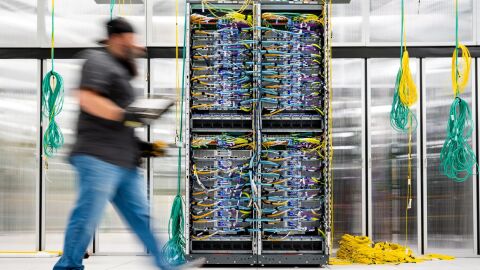This extends to all locations where we operate, and we are pleased to announce that our first Australian utility-scale renewable energy projects are now delivering clean energy to the Australian grid. The two solar farms in regional New South Wales (NSW) – one in Gunnedah and another in Suntop – are two of the 310 renewable energy projects across 19 countries helping Amazon stay on our path to powering our operations with 100% renewable energy by 2025, five years ahead of our original goal of 2030.
In 2020, Amazon announced its commitment to offtake 262 megawatts (MW) combined in clean energy capacity across three utility-scale renewable projects in Australia. Now, two of the projects are operational. Amazon Solar Farm Australia – Gunnedah and Amazon Solar Farm Australia – Suntop will aim to generate 392,000 MWh of renewable energy each year, equal to the annual electricity consumption of 63,000 Australian homes. Once Amazon Wind Farm Australia – Hawkesdale also becomes operational, it will boost the projects’ combined yearly renewable energy generation to 717,000 MWh or enough for nearly 115,000 Australian homes.
A global commitment
Amazon is committed to investing and innovating across its businesses to help create a more sustainable future. It’s important that large companies like Amazon stimulate investment in the development of green technologies and low-carbon products and services that will be required to help companies of all sizes decarbonise their operations. This is why we co-founded The Climate Pledge with Global Optimism, to inspire companies to commit to be net zero carbon by 2040, 10 years earlier than the Paris Agreement. Today more than 300 organisations globally have signed the pledge, including Procter & Gamble, HP, Salesforce, ASOS, and Nespresso. In 2021, we announced our first Australian signatory to The Climate Pledge, Canva, and our first New Zealand signatory, Xero.
Helping AWS customers monitor carbon emissions
At re:Invent 2021, AWS introduced the Sustainability Pillar as part of the AWS Well-Architected Framework, to help customers minimise the environmental impacts of running cloud workloads. It provides design principles, operational guidance, best-practices, potential trade-offs, and improvement plans customers can use to meet sustainability targets for their AWS workloads. The Sustainability Pillar is available to customers and AWS Partners at no additional charge in the AWS Management Console and is offered in all Regions where the AWS Well-Architected Tool is available.
In March we launched the AWS Customer Carbon Footprint tool, a dashboard that allows users of AWS and our services to calculate their organisation's carbon emissions, understand the emissions reductions realised by moving to AWS, and forecast how those numbers will change over time. We worked closely with Australian and New Zealand customers to develop and test the AWS Customer Carbon Footprint Tool.
The AWS Customer Carbon Footprint Tool is also proving to be a value-add for AWS partners like Stax, an Australian AWS native cloud management platform that’s available on AWS Marketplace. “A bold approach is required across all industries to create a more sustainable world. At Stax, we help customers accelerate their journey to the cloud through the innovation provided within the Stax platform.” said Adam Beavis, Managing Director at Stax. “We are thrilled to offer our customers access to the AWS Customer Carbon Footprint Tool – helping them see data points on the carbon emissions they’ve avoided by using Stax and by migrating to AWS. Like AWS, we are committed to running Stax in the most environmentally efficient way and supporting our customers to do the same.”
Energy efficient computing
AWS is committed to running its business in an efficient way to reduce our impact on the environment. Our scale allows us to achieve higher resource utilisation and energy efficiency than the typical on-premises data centre. AWS is continuously working on ways to increase the energy efficiency of its facilities and equipment, and innovating the design and manufacture of its servers, storage, and networking equipment to reduce energy and water use, and limit waste. Energy efficiency is the first fuel for lowering carbon emissions. That’s why AWS continues to be laser focused on improving efficiency in every aspect of our infrastructure. From the highly available infrastructure that powers our servers, to techniques we use to cool our data centres, to the innovative server designs we provide to our customers, energy efficiency is a key goal of our global infrastructure.
This spans everything from the systems that cool the buildings right down to the custom-built AWS Graviton2 processors in our servers, which provide better performance per watt than any other Amazon Elastic Compute Cloud (Amazon EC2) processor. Our third generation Arm-based processor AWS Graviton3, is more energy efficient, as Graviton3-based Elastic Cloud Compute instances use up to 60% less energy for the same performance than comparable Amazon EC2 instances. We also closely track resource usage to optimise utilisation, reduce energy, and increase operational excellence across our data centre equipment and infrastructure.
Our efforts were confirmed in a study by the global research and advisory firm 451 Research, which found that cloud infrastructure is five times more energy efficient than the median of surveyed on-premises enterprise data centres in Asia Pacific. More than two thirds of this advantage is from our energy efficient servers, with 451 Research concluding that moving IT workloads from on-premises data centres to the cloud in Australia would reduce associated carbon emissions on average by nearly 80%.[i]
For Australian enterprises and public sector organisations, this equates to an estimated annual carbon reduction of 3,149 metric tonnes of carbon dioxide equivalent (CO2e) per MW of enterprise data centre capacity. That’s the equivalent of greenhouse gas emissions savings from more than 650 cars driven for one year.[ii] Further, the research found that if cloud providers could power their operations on 100 % renewable energy, customers would benefit from up to 15 % additional carbon reduction.
Sustainable for the long term
We are optimistic about the future, and our hope is that, through a combination of technological leadership, investment, and innovation, we can reduce our own impact on the world, provide our customers with the sustainable computing power they need to solve innovative challenges, and inspire other companies to join us on the journey.
[i] 451 Research surveyed 515 organisations in Asia Pacific (APAC), including over 100 in Australia, with annual revenues between US$10 million and US$1 billion, across a variety of industries including manufacturing, healthcare and financial services. Other markets covered in the study include Japan, South Korea, Singapore and India.
[ii] From moving one quarter of one average company’s IT workloads to the cloud. Note in the 451 study, the mean amount of IT equipment for large enterprise and public sector organizations was 4MW. 650 cars emissions calculated using the Greenhouse Gas equivalencies calculator: https://www.epa.gov/energy/greenhouse-gas-equivalencies-calculator
[1] From moving one quarter of one average company’s IT workloads to the cloud. Note in the 451 study, the mean amount of IT equipment for large enterprise and public sector organizations was 4MW. 650 cars emissions calculated using the Greenhouse Gas equivalencies calculator: https://www.epa.gov/energy/greenhouse-gas-equivalencies-calculator
[1] 451 Research surveyed 515 organisations in Asia Pacific (APAC), including over 100 in Australia, with annual revenues between US$10 million and US$1 billion, across a variety of industries including manufacturing, healthcare and financial services. Other markets covered in the study include Japan, South Korea, Singapore and India.












